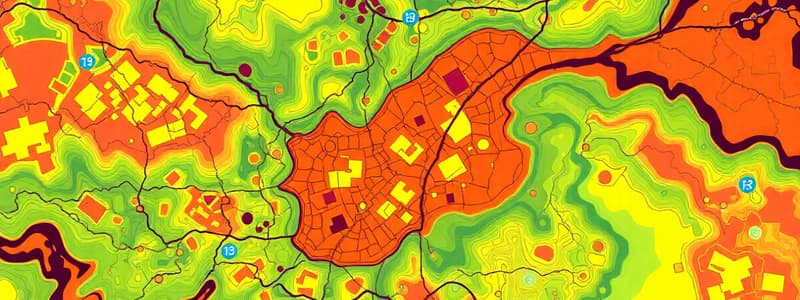Podcast
Questions and Answers
What is the primary advantage of using aerial and satellite images?
What is the primary advantage of using aerial and satellite images?
- They provide reliable information without touching the environment. (correct)
- They can only cover small spatial areas.
- They generate data records that expire quickly.
- They require physical contact with objects.
What does reflection of electromagnetic radiation involve?
What does reflection of electromagnetic radiation involve?
- The passing of radiation through a material.
- The emission of radiation from a surface.
- The bouncing off of radiation from a surface. (correct)
- The absorption of energy into heat.
Which of the following best describes irradiance?
Which of the following best describes irradiance?
- The ratio of radiance to the amount of light striking a surface.
- The radiation incident on a surface. (correct)
- The light reflecting off a surface.
- The rate at which electromagnetic radiation is emitted.
What characteristic is significantly high in the spectral signature of vegetation?
What characteristic is significantly high in the spectral signature of vegetation?
What does orthogonal aerial photography achieve?
What does orthogonal aerial photography achieve?
Which aspect of digital air photo imagery is mentioned as lacking?
Which aspect of digital air photo imagery is mentioned as lacking?
What defines frequency in the context of wavelengths?
What defines frequency in the context of wavelengths?
What are the types of digital raster data resolution?
What are the types of digital raster data resolution?
What is the main difference between block and focal neighborhood analysis?
What is the main difference between block and focal neighborhood analysis?
Which of the following defines a zonal function?
Which of the following defines a zonal function?
What do Digital Elevation Models (DEMs) represent?
What do Digital Elevation Models (DEMs) represent?
How is slope defined in terrain analysis?
How is slope defined in terrain analysis?
What does flow accumulation represent in GIS analysis?
What does flow accumulation represent in GIS analysis?
What role does terrain analysis play in GIS?
What role does terrain analysis play in GIS?
Which of the following best describes aspect in terrain analysis?
Which of the following best describes aspect in terrain analysis?
What advantage do aerial and satellite images offer in geographic analysis?
What advantage do aerial and satellite images offer in geographic analysis?
What does the spectral aspect of remote sensing refer to?
What does the spectral aspect of remote sensing refer to?
How is NDVI calculated and interpreted?
How is NDVI calculated and interpreted?
What are false-color composite images primarily used for?
What are false-color composite images primarily used for?
What distinguishes hyperspectral imaging from multispectral imaging?
What distinguishes hyperspectral imaging from multispectral imaging?
Which statement accurately describes passive and active sensors in remote sensing?
Which statement accurately describes passive and active sensors in remote sensing?
What is LiDAR and how is it classified?
What is LiDAR and how is it classified?
What does the concept of 'return' refer to in elevation data collection?
What does the concept of 'return' refer to in elevation data collection?
Why might NDVI values become less useful at high biomass levels?
Why might NDVI values become less useful at high biomass levels?
Flashcards
Neighborhood Analysis
Neighborhood Analysis
Analyzing data by looking at the characteristics of a specific area around a given point or cell.
Zonal Function
Zonal Function
An operation on data that is applied to different areas (zones) with unique attributes or identifiers.
Terrain Analysis
Terrain Analysis
Studying the characteristics and features of land surfaces using GIS
Digital Elevation Models (DEM)
Digital Elevation Models (DEM)
Signup and view all the flashcards
Slope
Slope
Signup and view all the flashcards
Aspect
Aspect
Signup and view all the flashcards
Flow Direction
Flow Direction
Signup and view all the flashcards
Aerial/Satellite Images
Aerial/Satellite Images
Signup and view all the flashcards
Aerial Images
Aerial Images
Signup and view all the flashcards
Satellite Images
Satellite Images
Signup and view all the flashcards
Reflection (Radiation)
Reflection (Radiation)
Signup and view all the flashcards
Absorption (Radiation)
Absorption (Radiation)
Signup and view all the flashcards
Transmitted Radiation
Transmitted Radiation
Signup and view all the flashcards
Wavelength
Wavelength
Signup and view all the flashcards
Frequency
Frequency
Signup and view all the flashcards
Spectral Signature
Spectral Signature
Signup and view all the flashcards
NDVI
NDVI
Signup and view all the flashcards
False-color composite images
False-color composite images
Signup and view all the flashcards
Hyperspectral imaging
Hyperspectral imaging
Signup and view all the flashcards
Multispectral imaging
Multispectral imaging
Signup and view all the flashcards
Passive sensor
Passive sensor
Signup and view all the flashcards
Active sensor
Active sensor
Signup and view all the flashcards
LiDAR
LiDAR
Signup and view all the flashcards
First Returns in LiDAR
First Returns in LiDAR
Signup and view all the flashcards
Last Returns in LiDAR
Last Returns in LiDAR
Signup and view all the flashcards
Study Notes
Lecture 15: Neighborhood Analysis and Zonal Functions
- Neighborhood analysis uses a "moving window" to evaluate cells within a defined area.
- Output from a moving window operation is based on the cell at the window's center.
- Focal analysis evaluates cells one at a time, creating overlapping neighborhoods.
- Zonal functions apply operations to defined regions or zones.
- Zonal analysis uses defined areas of interest (like a country) to summarize data points like total population.
- It employs a zonal statistics tool for data summarization.
Lecture 15: Terrain and Terrain Analysis
- Terrain analysis interprets topographic features like slope, aspect, and viewshed.
- Terrain is where water flows, lakes form, and land is affected by floods.
- Terrain analysis examines how terrain features influence various aspects, such as soil moisture and food production.
- Terrain analysis is conducted through Geographic Information Systems (GIS)
Lecture 15: Terrain Models
- Models used for terrain analysis include elevation contours, digital elevation models (DEMs), triangular irregular networks (TINs), 3D point clouds, and LiDAR.
Lecture 16: Aerial and Satellite Imagery
- Aerial imagery is taken from aircraft.
- Satellite imagery is taken from satellites.
- Both provide advantages in observing environments without physical contact. These methods provide reliable information about physical objects and long spatial coverage.
Lecture 16: US Terrain Data
- USGS and NOAA/FEMA use high-resolution LiDAR, particularly in coastal areas.
Lecture 16: DEM Derivatives
- DEM derivatives (slope, aspect, curvature, flow direction) are calculated using neighborhood analysis.
Lecture 16: Slope and Aspect
- Slope is the change in elevation over a horizontal distance (rise over run).
- It's measured in percent or degrees.
- Aspect is the direction a slope faces.
Lecture 16: Flow Direction, Accumulation, and Watersheds
- Flow direction follows the steepest downhill path.
- Flow accumulation counts upstream cells that drain into a specific cell.
- Watersheds include all cells that drain into a single outlet.
Lecture 17: Raster Data Resolution
- Spatial resolution of raster data is the size of the instantaneous field of view.
- Temporal resolution is how often data is acquired.
- Radiometric resolution describes the sensitivity of detectors to small brightness differences.
- Spectral resolution measures the number and width of spectral regions the sensor records.
Lecture 17: NDVI
- Normalized Difference Vegetation Index (NDVI) is calculated using near-infrared (NIR) and red (RED) reflectance.
- Higher NDVI values indicate denser vegetation.
- NDVI values below a threshold might represent non-vegetated areas.
Lecture 17: False-Color Composite Images.
- False-color composite images combine different bands of imagery.
- This is used to highlight characteristics of land surfaces.
Lecture 17: Hyperspectral Imaging
- Hyperspectral data have hundreds of narrow spectral bands.
- Multispectral data have fewer, wider spectral bands. This is a key difference between the data types.
Lecture 17: Sensors
- Passive sensors use energy from the sun.
- Active sensors use their own energy source, like LiDAR.
Lecture 17: LiDAR
- LiDAR, or Light Detection and Ranging, uses lasers to measure distance.
- LiDAR data is an active remote sensing technology.
Lecture 17: "Return"
- "Return" calculations, like First and Last Returns, allow for obtaining elevation data accurately.
Studying That Suits You
Use AI to generate personalized quizzes and flashcards to suit your learning preferences.





